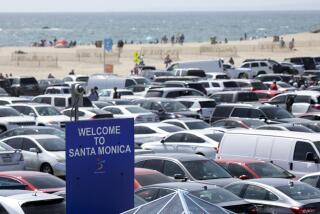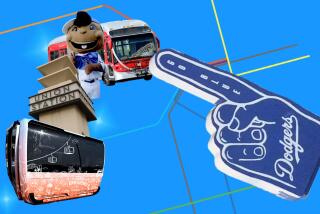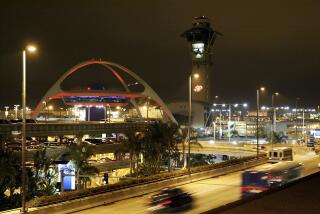Rates Are <i> Lowered</i> at Lindbergh Lot
- Share via
When airport officials increased parking rates at Lindbergh Field last May, they wanted to discourage people from parking for more than a day. And it worked.
The problem is it worked too well.
So, faced with a dizzying drop of 60% in long-term parkers, the agency that operates the airport did the unheard-of Tuesday: it slashed rates at one of the four parking lots near the airport.
The cost to park at the 800-space parking lot off Harbor Drive across from the West Terminal will be decreased from $18 a day after the first day to a flat $12, the same rate as the first day. A car parked in this lot for two days and two hours, for example, will now pay $26 instead of $48.
Rates at the other three main lots next to the airport, used primarily by people parking for less than two hours, will remain the same. It costs $12 the first day and $18 each day thereafter to park in those lots, which have a total of 2,456 spaces.
Last May, the Board of Port Commissioners increased the cost of parking because of severe crowding during peak travel times. Long-term parkers were monopolizing spaces closest to the terminals, leaving those who were there simply to drop off a friend or relative frustrated and disgruntled as they searched for vacant stalls.
One result at the terminals was more curbside congestion. More hassles and more complaints. That’s what happens when people try to get 11 million passengers in and out of a small airport each year.
The San Diego Unified Port District, which operates Lindbergh Field, estimated in May that the price increase imposed then would drop the demand for long-term parking by half. But a survey in September and October showed the drop-off was 60%, while the total number of vehicles parking at the airport decreased by 5% from the same period in 1989.
Parking revenue to the Port District was also down during the two months, even while the number of passengers using the airport continued to increase.
The reason for the turnaround, according to Port District officials, is that passengers are using taxis, shuttles and private park-and-ride facilities more than ever before. In fact, this year the number of so-called courtesy vehicles and shared-ride commercial shuttles has increased by 12%, and the trend is expected to continue.
One effect has been a noticeable reduction in curbside congestion, port officials say, because people can now find enough short-term parking stalls near the terminals.
And another effect, in the word of Port Director Don Nay, is the “underemployment” of Lot 4, the designated long-term parking lot.
More to Read
Sign up for Essential California
The most important California stories and recommendations in your inbox every morning.
You may occasionally receive promotional content from the Los Angeles Times.













